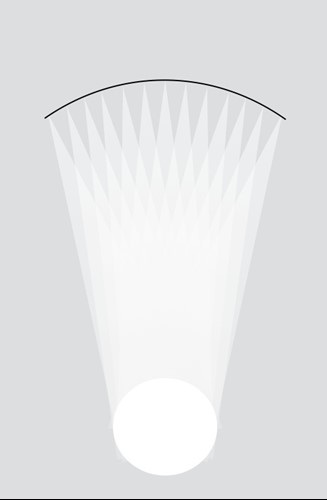What you should know about medical lamps? Which parameters are important in everyday work and what might be called "marketing tricks"? What is the difference between surgical operating lamp and diagnostics? This short guide will help you choose the best solution.
LIGHT INTENSITY
This parameter tells you, how much light a lamp is generating. Illuminance is the only size which does not characterize source of light, but the brightness of the surface illumination. The unit of illuminance is lux (lx).
Workplace illuminance is defined by European standards. This standard assumes that the required illumination, in order to perceive the features of a human face, in normal lighting conditions, shall not be less than 20 lux and it is the smallest illuminance mentioned by the standard. In typical office work, such as handwriting, typing, reading, keyboard handling requires illuminance of 500 lux. However, for precision work it exceeds 1.000 lux. On a sunny summer day, the lighting in unshaded area, reaches a value of 100 000 lux.
For medical lighting, the point of reference is the EN 60601-2-41 standard. In accordance with the requirements of this standard, operating lights should generate light with a minimum value of 40 000 lux at a central point. However, most manufacturers offer lamp illumination from 120 000 to 160 000 lux.
For comparison:
- earth surface illuminated by the full moon, on a clear night - from 0,1 to 0,2 lux
- street lighting at night - from 2 to 5 lux
- room, from the shaded side, in the middle of the day - 300 lux
- earth surface illuminated by the sun, outdoor, overcast - 5 000 lux
- sunny summer day (clear sky) - 100 000 lux
COLOUR RENDERING
The color impression of the illuminated surface, depends on the composition of the light wave. For this reason, the spectrum of light plays a very important role. Cool white light accentuates the colors of blue, purple and green. Warm white light emphasizes shades of red, yellow and orange.
Colour Rendering Index (CRI) determines how light reflects the colors of the illuminated surface in comparison with the donation of colors in natural daylight. Ratio close to 100 means that the color of the illuminated object are seen as in natural daylight.
Lamps with a high ratio of CRI, are required during the operation and treatment, including dermatological procedures. Be aware that the color rendering is also influenced by the color temperature of the lighting. In some medical procedures, it is required to adjust the temperature of lighting, to the nature of the surgery, to provide the highest visibility of tissues.
| Color of the light source | Light temperature in Kelvin |
| warm white | < 3300 K |
| neutral white | 3300 - 5300 K |
| cool white (daylight) | >5300 K |

For comparison, below is presented a color pattern, photographed with a source of illumination with different color temperatures.
Board illuminated by light of 3500 K
Board illuminated by light of 4500 K
Board illuminated by light of 5500 K
SHADOWLESS LIGHT
Light and shadow play a decisive role in spatial orientation. However, during operation, the shaded areas can affect the perception of details difficult. To achieve a high degree of shadowless light, lamp manufacturers use several different solutions.
The best results are achieved by using a number of individual light sources illuminate the treatment area at various angles. Even if part of the light source is masked, the remaining lighting allows to perform the surgery with equally good performance lighting.
 Optical Solutions developed by FAMED ensure optimum illumination of the working area. Glare-free, shadowless FAMED operating lamps provide excellent conditions for carrying out every possible medical procedure.
Optical Solutions developed by FAMED ensure optimum illumination of the working area. Glare-free, shadowless FAMED operating lamps provide excellent conditions for carrying out every possible medical procedure.
